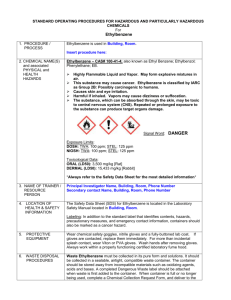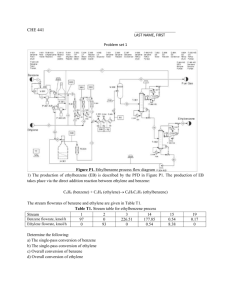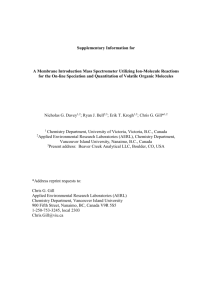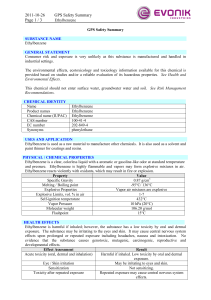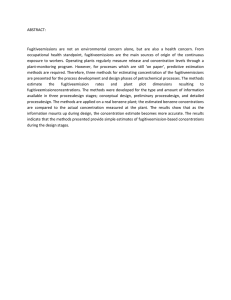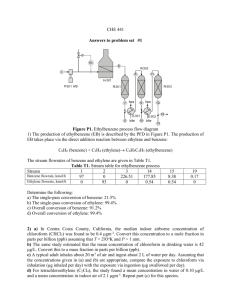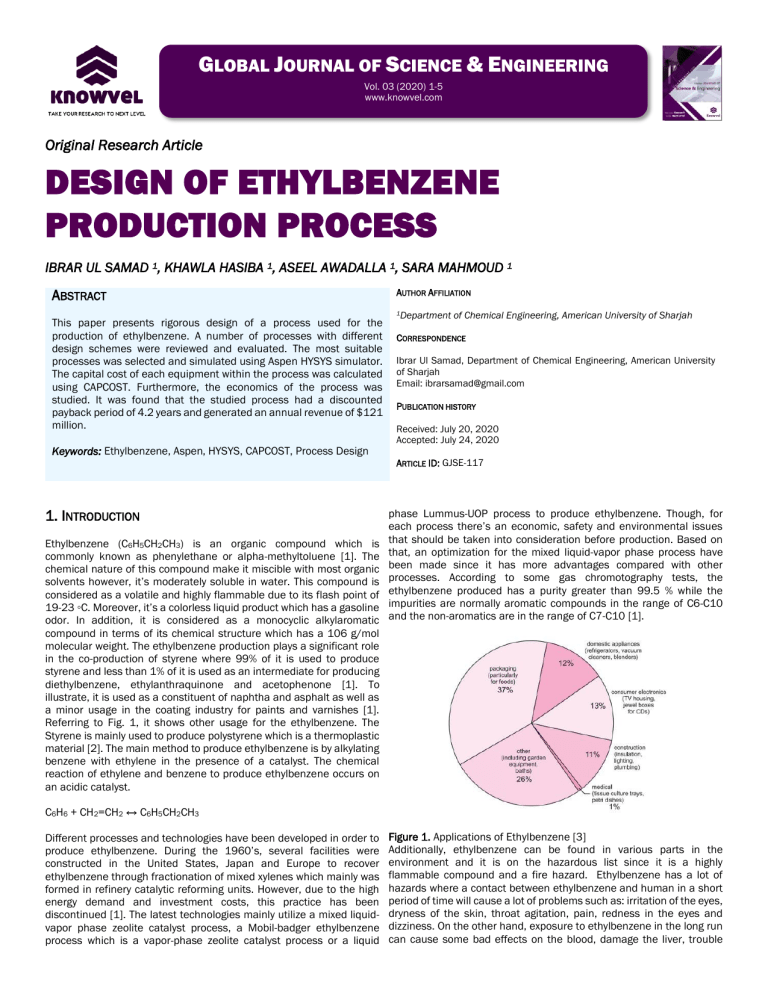
GLOBAL JOURNAL OF SCIENCE & ENGINEERING Vol. 03 (2020) 1-5 www.knowvel.com Original Research Article DESIGN OF ETHYLBENZENE PRODUCTION PROCESS IBRAR UL SAMAD 1, KHAWLA HASIBA 1, ASEEL AWADALLA 1, SARA MAHMOUD 1 ABSTRACT This paper presents rigorous design of a process used for the production of ethylbenzene. A number of processes with different design schemes were reviewed and evaluated. The most suitable processes was selected and simulated using Aspen HYSYS simulator. The capital cost of each equipment within the process was calculated using CAPCOST. Furthermore, the economics of the process was studied. It was found that the studied process had a discounted payback period of 4.2 years and generated an annual revenue of $121 million. Keywords: Ethylbenzene, Aspen, HYSYS, CAPCOST, Process Design AUTHOR AFFILIATION 1Department of Chemical Engineering, American University of Sharjah CORRESPONDENCE Ibrar Ul Samad, Department of Chemical Engineering, American University of Sharjah Email: ibrarsamad@gmail.com PUBLICATION HISTORY Received: July 20, 2020 Accepted: July 24, 2020 ARTICLE ID: GJSE-117 1. INTRODUCTION Ethylbenzene (C6H5CH2CH3) is an organic compound which is commonly known as phenylethane or alpha-methyltoluene [1]. The chemical nature of this compound make it miscible with most organic solvents however, it’s moderately soluble in water. This compound is considered as a volatile and highly flammable due to its flash point of 19-23 ◦C. Moreover, it’s a colorless liquid product which has a gasoline odor. In addition, it is considered as a monocyclic alkylaromatic compound in terms of its chemical structure which has a 106 g/mol molecular weight. The ethylbenzene production plays a significant role in the co-production of styrene where 99% of it is used to produce styrene and less than 1% of it is used as an intermediate for producing diethylbenzene, ethylanthraquinone and acetophenone [1]. To illustrate, it is used as a constituent of naphtha and asphalt as well as a minor usage in the coating industry for paints and varnishes [1]. Referring to Fig. 1, it shows other usage for the ethylbenzene. The Styrene is mainly used to produce polystyrene which is a thermoplastic material [2]. The main method to produce ethylbenzene is by alkylating benzene with ethylene in the presence of a catalyst. The chemical reaction of ethylene and benzene to produce ethylbenzene occurs on an acidic catalyst. phase Lummus-UOP process to produce ethylbenzene. Though, for each process there’s an economic, safety and environmental issues that should be taken into consideration before production. Based on that, an optimization for the mixed liquid-vapor phase process have been made since it has more advantages compared with other processes. According to some gas chromotography tests, the ethylbenzene produced has a purity greater than 99.5 % while the impurities are normally aromatic compounds in the range of C6-C10 and the non-aromatics are in the range of C7-C10 [1]. C6H6 + CH2=CH2 ↔ C6H5CH2CH3 Different processes and technologies have been developed in order to produce ethylbenzene. During the 1960’s, several facilities were constructed in the United States, Japan and Europe to recover ethylbenzene through fractionation of mixed xylenes which mainly was formed in refinery catalytic reforming units. However, due to the high energy demand and investment costs, this practice has been discontinued [1]. The latest technologies mainly utilize a mixed liquidvapor phase zeolite catalyst process, a Mobil-badger ethylbenzene process which is a vapor-phase zeolite catalyst process or a liquid Figure 1. Applications of Ethylbenzene [3] Additionally, ethylbenzene can be found in various parts in the environment and it is on the hazardous list since it is a highly flammable compound and a fire hazard. Ethylbenzene has a lot of hazards where a contact between ethylbenzene and human in a short period of time will cause a lot of problems such as: irritation of the eyes, dryness of the skin, throat agitation, pain, redness in the eyes and dizziness. On the other hand, exposure to ethylbenzene in the long run can cause some bad effects on the blood, damage the liver, trouble breathing, cancer and sometimes can lead to death. In addition, it has However, it is important to note that this process still produces residual been found that ethylbenzene has some effects on the liver, kidneys oil as one of its final by-products which can cause significant pollution and blood of the animals [4]. and therefore, should be dealt properly by recycling or reusing it for other chemical processes. Additionally, the catalyst, albeit it has a long lifetime, still needs to be properly disposed off, as it can cause damage 2. PROCESS DESIGN ALTERNATIVES to the environment. 2.1. Literature Survey 2.2.3. Economic Issues S. Liu et al. [5] discussed the production of ethylbenzene using liquidphase benzene and vapor-phase ethylene feed. This industrial process 1) The major cost in this process comes from the use of expensive catalysts that are crucial to the process. is highly selective in the production of ethylbenzene. The process involves an alkylation section (the reactor vessel) and a trans-alkylation 2) Another important economic issue to consider would be the design and manufacture of the alkylation reactor. The alkylation would section. Additionally, the ethylbenzene produced is used to heat the serve the dual purpose of housing the catalytic reaction and reactor vessel, saving in energy costs. This process combines the standard distillation. Combining both these processes together catalytic reaction and distillation into a single process, whereby the means that the reactor column has to be designed from scratch energy produced by the heat of reaction is used to drive the distillation leading to increased capital costs. of the produced products. The process was developed by the CDTECH. Lastly, the reactor operates at a temperature of 140-185 °C and a 2.3. Vapor-Phase Zeolite Catalyst Process pressure of 1.6-2.1 MPa. E. B. Pandhare [6] outlined the various different methods of the manufacture of ethylbenzene. Although it is a good reference, it will be primarily used for the study of the production of ethylbenzene using vapor-phase process that also involves the zeolite catalyst. This process was developed jointly by Mobil and Badger and is commonly referred to as the Mobil-Badger process. The Mobil-Badger process is also the most successful of all the vapor phase technologies used for the production of ethylbenzene. It involves the use of the reactants in vapor phase in the alkylation units. Additionally, the reaction is carried out at 400-450 °C and 2-3 MPa. R. E. Kirk et al. [7] provided a detailed outlook on many processes in the chemical industry including the ones that produce ethylbenzene. It also outlines a process called the Unocal-Lummus-UOP ethylbenzene process, where ethylbenzene using the reactants in the liquid phase on a zeolite catalyst. This process is quite similar to the Mobil-Badger process but the yield of ethylbenzene is low and is laced with impurities in the form of aromatics and non-aromatics. The reaction is carried out 270 °C and 3.79 MPa. 2.2. Mixed Liquid-Vapor Phase Zeolite Catalyst Process 2.2.1. Process Description This process involves the use of a Y zeolite catalyst, capable of converting benzene and dilute ethylene to ethylbenzene [5],[8]. The catalyst itself has excellent resistances to sulfur and water and also has good regeneration qualities, all the while ensuring great ethylene conversion, good ethylbenzene selectivity and longer operational period [5]. The alkylation reactions take place in an alkylation reactor which primarily consists of two sections: the catalytic distillation section and the standard distillation section. The catalytic bed is found at the top of the column [8]. Benzene is fed as a liquid from the top of the column while the ethylene is fed as a vapor from the bottom of catalytic section. This counter-current action causes the ethylene to rapidly dissolve in the benzene liquid phase and react to form ethylbenzene on the catalyst sites. Since, the reaction is extremely exothermic, the energy is used to cause distillation of the products, namely, ethylbenzene & poly-ethylbenzene (PEB). The alkylation reaction is carried out at a temperature of 140-185 °C and a pressure of 1.6-2.1 MPa [5]. After separation of the PEB, the transalkylation reactions take place is another reactor. 2.2.2. Safety & Environmental Issues There are no significant environmental and safety issues with this process as it operates at a relatively low temperature and pressure. 2.3.1. Process Description The Mobil–Badger ethylbenzene process is considered to be the most successful vapor phase technology [6]. In this process, fresh benzene stream is vaporized and pre-heated to a certain temperature; after which it is fed to multistage of fixed-bed reactor containing the zeolite catalyst. Moreover, the ethylene stream is introduced to the reactor through multiple stages to enhance contact between the reactants. The alkylation occurs in the vapor phase at a temperature range from 400 °C to 450°C and the pressure for each plant is usually between 2-3 MPa [6]. The polyethyl-benzene (PEB) recovered from the distillation column is mixed with benzene. After heating and vaporizing the mixture, it is fed into a transalkylator where the PEB reacts with the benzene to form additional ethylbenzene. The effluent from the reactor, consisting of unreacted benzene, PEBs, trace impurities and ethylbenzene, is fed into a “benzene column” for distillation. Benzene is removed from the top of the column, along with light hydrocarbons. These are stripped in an overhead stripper with the benzene being recycled to the reactors again, while the light hydrocarbons are vented to be used as a fuel [6]. The presence of light hydrocarbons can be attributed mostly to the ethane in the ethylene feed and non-aromatic components that decompose in the fresh benzene feed. The bottoms product from the benzene column is fed in the ethylbenzene column to recover ethylbenzene from the top, while the bottoms product consisting of PEB is fed into a PEB column for further distillation. This column generates PEB as an overhead product which is recycled to the transalkylator for the production of ethylbenzene. The bottoms product is known as “residue” and is usually found in very small quantities and is also used as a fuel [6]. The catalyst in this process is zeolite based and “is less sensitive to water, sulfur and other poisons than the Lewis acid catalysts” [6]. Due to coke formation overtime as a result of high temperature, the catalyst becomes deactivated. Hence, it is important to regenerate the catalyst from time to time. This regeneration takes up-to 36 hours and is important after every 6-8 weeks of operation [6]. Therefore, it is important that the process has two parallel reactors, where one reactor is used when the other is taken out of production because catalyst regeneration. 2.3.2. Safety & Environmental Issues 1) The alkylation reaction takes place at high temperature (400-450 °C) and high pressure (2-3 MPa). This means that the column would need to be constructed out of special materials of construction in order to safely accommodate such high pressures and temperatures. 2 2) Formation of coke on the catalyst means that it needs to be 3) To accommodate the high pressure in the reactor, more material regenerated from time to time. This regeneration is done by the is required for safe use. This also leads to an increased burning the catalyst to form CO2. CO2 is a greenhouse gas and expenditure in capital costs. causes significant environmental damage by destroying the ozone layer. 3. PROCESS SELECTION 3) High temperatures also result in side-reactions of byproducts, such as aromatics, are known to be carcinogenic and also Based on the literature review, it was decided to opt for the mixed mutagenic. liquid-vapor phase process for the production of ethylbenzene. This process has many more advantages over the other processes. One of 2.3.3. Economic Issues the key advantages is that it does not need a pure ethylene and benzene feed and can therefore, produce ethylbenzene feed from 1) In order to regenerate the catalyst, specific regeneration dilute feeds. Furthermore, this process would not require a preequipment would be required which increases the capital cost of treatment phase, reducing any operating and capital costs. the plant [6]. Additionally, the mixed liquid-vapor phase has a high yield and 2) Since the reactors are taken off for catalyst regeneration, a selectivity of ethylbenzene [5] when compared to other processes. substitute reactor needs to be present to continue production. Lastly, the process operates at reasonable temperatures and This also causes the capital cost to be increased. pressures that are not too high. Not only would this reduce operating 3) High temperatures and pressures mean that the equipment needs and capital costs, but would also provide a safe working environment to be made out of special materials of constructions which can be as there is less danger for an explosion or fire to take place. expensive, leading to increased costs. Considering all these factors and comparing them to the other two 4) Lastly, high temperatures and pressures also cause an increase in processes it seems reasonable to select the mixed liquid-vapor phase energy costs which lead to an increase in operating costs. process developed by CDTECH. 2.4. Liquid-Phase Zeolite Catalyst Process 2.4.1. Process Description 4. RESULTS & DISCUSSION 4.1. HYSYS Simulation This process is similar to the Mobil-Badger vapor phase etylbenzene process. However, some differences arise in the catalysts, reactor sizes, yelds, reaction conditions and product specifications. In order to maximize the productivity of the catalyst in the Lummus process, the reactors have to operate nearly to the crtitical temperature of the reaction mixture which is around 270 ˚C, and an appropriate pressure is required in order to keep the reaction mixture in the liquid phase which is approximately 3.79 MPa [7]. In addition, a compressor is needed unless the ethylene’s supply pressure is enough to deliever it to the reactor [7]. Furthermore, large amount of catalyst is required in two multistage transalkylator and alkylators and water is added to moderate the activity of the catalyst. On the other hand, the benzene feed is pretreated in a clay treaters; while the remaining C6 Figure 2. HYSYS Simulation nonaromatics are removed by purging a portion of the recycled benzene which is called “drag benzene”. The overall yield of the Table 1. Material stream results ethylbenzene produced from this process is around 98-98.5%, with the residue of the PEB column being the reason for a low yeild of ethylbenzene. This process isn’t recommended for low concentration ethylene feeds and in order to have enough liquid to dissolve the diluents (mainly, C1, C2 and hydrogen), the benzene recycle would have been raised up to an uneconomical level. Additionally, the ethylbenzene produced from this process also contains significant amount of impurities in the form of aromatics. These aromatics include xylene, cumene and ethyltoluene. Moreover, there are also nonaromatic compounds present in the product [7]. Table 2. Stream Compositions 2.4.2. Safety & Environmental Issues 1) 2) The reactor operates at 3.79 MPa which is a very high pressure. Hence, the reactor needs to have a greater thickness in order to accommodate such high pressure. The production of residue and drag benzene could cause environmental pollution if not disposed properly. 2.4.3. Economic Issues 1) 2) Table 3. Energy streams More alkylation reactors are needed leading to increase in capital costs. The feed needs to be pure ethylene and benzene; hence, specific equipment needs to be installed for pre-treatment. This leads to increase in capital costs. 3 4.1.1. Simulation Assumptions No material lost due to leaks Pure product formed (i.e. no formation of heavy flux oil) Pure ethylene and benzene available All reflux ratios are 1.5 times the minimum reflux ratio For reactive distillation, the column is divided into a conversion reactor and shortcut distillation column to aid in simulation design Only diethylbenzene is produced in the side reaction Conversion of ethylene and benzene to ethylbenzene is kept at 85% in CRV-100. While for formation of diethylbenzene, conversion is 10%. Conversion of diethylbenzene in the second reactor, CRV-101, is at 90% Column for purification of product from flux oil not required, as it is assumed no flux oil is produced 4.2. List of Equipment, Sizing & Cost Table 4. Equipment, Sizing and Cost Figure 3. Cost of equipment Total Bare Module Cost: $4,664,800 Figure 4. Cost of utilities 4.2.1. Assumptions for Sizing & Cost Analysis Length between each plate in the towers is 1.5 m For flash vessel, HYSYS is used for sizing CAPCOST is used for costing 4.3. Cost Analysis using CAPCOST Payback Period (Discounted): 4.2 years Payback Period (Non-Discounted): 3.0 years Annual Revenue: $121,035,000 Since, the final NPV value is positive ($9.72 million) in year 12, it can be concluded that this project is profitable. Additionally, as per our findings using CAPCOST, the discounted payback period is 4.2 years. This indicates that the project starts to have a profit after 4.2 years, hence it is feasible. In order to calculate these values, the annual cost of product and raw materials needed to be found. Using [9], the price of benzene and ethylene was found to $0.74/Kg and $0.978/Kg, respectively. However, to have a more conservative estimate due to fluctuations in prices, both the prices of benzene and ethylene are taken to be $1/Kg. Figure 5. COMd plus revenue 4 REFERENCES [1] “1.2 Manufacturing: Ethylbenzene", Ethylbenzene.org, 2016. [Online]. Available: http://www.ethylbenzene.org/content/1-2.html. [Accessed: 07- Dec- 2016]. [2] D. C. Marchant, OPTIMIZATION: A PERSPECTIVE ON IMPROVING AN ETHYLBENZENE PRODUCTION DESIGN. M.S. Thesis. Oxford, Mississippi, USA: University of Mississippi, 2015. Available: http://thesis.honors.olemiss.edu/389/13/Marchant%20Thesis.pdf Figure 6. Non-Discounted cash flow analysis [3] Poly(phenylethene) (Polystyrene)", Essentialchemicalindustry.org, 2016. [Online]. Available: http://www.essentialchemicalindustry.org/polymers/polyphenylethen e.html. [Accessed: 07- Dec- 2016]. [4] Material Safety Data Sheet: Ethylbenzene MSDS, ScienceLab. [Online]. Available: http://www.sciencelab.com/msds.php?msdsId=9923958. [Accessed: 07- Dec- 2016]. [5] S. Liu, F. Chen, S. Xie, P. Zeng, X. Du and L. Xu, "Highly selective ethylbenzene production through alkylation of dilute ethylene with gas phase-liquid phase benzene and transalkylation feed", Journal of Natural Gas Chemistry, vol. 18, no. 1, pp. 21-24, 2009. Figure 7. Discounted and non-discounted cash flow analysis 4. CONCLUSIONS [6] E. B. Pandhare, "Manufacturing of Ethylbenzene", Scribd. [Online]. Available: https://www.scribd.com/doc/122192192/Manufacturingof-Ethylbenzene. [Accessed: 12- Oct- 2016]. [7] R. Kirk, D. Othmer, J. Kroschwitz and M. Howe-Grant, Encyclopedia of chemical technology. New York: Wiley, 1991. This paper presented a rigorous design of a process used for the production of ethylbenzene. It was found that the most suitable process [8] W. Yang, Z. Wang, H. Sun and B. Zhang, "Advances in development and industrial applications of ethylbenzene processes", Chinese had a discounted payback period of 4.2 years and generated an annual Journal of Catalysis, vol. 37, no. 1, pp. 16-26, 2016. revenue of $121 million. CONFLICT OF INTERESTS The authors declare that there is no conflict of interest related to the publication of this article. [9] "Latest Oil, Energy & Metals News, Market Data and Analysis | Platts", Platts.com, 2016. [Online]. Available: http://www.platts.com/. [Accessed: 26- Nov- 2016]. 5
